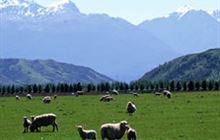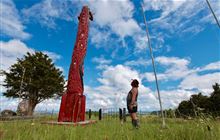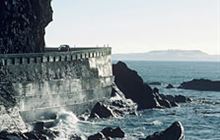Introduction
We actively manage 660 key heritage sites that reflect many themes of New Zealand history. Find heritage sites by topic.A significant theme is Māori, encompassing archaeological sites that reflect most aspects of Māori life. The early European contact period is represented by exploration, sealing and whaling, and the New Zealand wars.
More recent sites focus on important people and events such as Governor Grey’s mansion, the North Head fortifications and government buildings. A distinctive group are the 40 historic huts related to recreation, deer culling and mustering. DOC is a major manager of bridge heritage with 28 historic bridges.
Other themes involve industrial and economic use, gold and coal mining, timber, farming and transport. Also there are themes which focus on the environment; conservation, recreation and tourism.
The main topics represented on land managed by DOC are:

Artefacts and archives
DOC manages significant artefact and archive collections at some of its relatively remote visitor centres. This is an inheritance from earlier times when visitor centres were regarded as the local museum.

Bridges
Discover some of the historic bridges that can be found on DOC-managed lands.

Defending New Zealand
Explore sites with coast defence installations that were built to defend New Zealand from naval attack between 1880 and 1945.

European discovery
Visit DOC sites where you can learn more about the European explorers, sealers, whalers, missionaries and colonists who came to New Zealand.

Farming - general
Visit farming heritage sites that illustrate the importance of agriculture in New Zealand since the arrival of European settlers.

Farming - high country
High country sheep stations were run on an annual cycle of mustering and shearing. You can visit some of the sites where these activities were carried out and learn about New Zealand's high country farming heritage.

Government services
Visit some of the historic government sites where history was made: Flagstaff Hill, Cuvier Light Station, Urquhart's Hut, and Antipodes Island Castaway Provision Depot to name just a few.

Ill-fated settlement
Visit sites where some of New Zealand's ill-fated settlements have stood including Tongariro Farm Site, Mangapurua Valley Soldiers Settlement and Jamestown Settlement.

Machinery
At some DOC sites you can see remnants of the machines that were once used for gold mining, timber milling, whaling, producing power and other activities.

Māori sites
Trace our heritage back through the large collection of Māori sites we manage.

Maritime
Learn the importance of maritime navigation throughout New Zealand's history by visiting DOC-managed maritime heritage sites.

Mining - coal
Discover the history behind New Zealand's coal mining industry by visiting DOC-managed historic sites like Benneydale Coal Mine in Waikato and Brunner Mine on the West Coast.

Mining - general
Find out about past mining activities in New Zealand by visiting mining heritage sites. From Northland's Puhipuhi Mercury Mines to Stewart Island's Port Pegasus Tin Mining, these DOC-managed sites show the important role mining has played in New Zealand's history.

Mining - gold
By visiting DOC-managed gold mining history sites you can learn about New Zealand's gold mining history that began with the Coromandel rush of 1852.

Nature conservation
Discover DOC lands that illustrate the various impacts humans have had on New Zealand's biodiversity through the centuries.

New Zealand Wars
Visit New Zealand Wars heritage sites to learn more about the conflict between Maori and Government forces that included the Crown’s Maori allies.

Power generation
There are a number of power generation sites on lands managed by DOC including the Dawson Falls Power Station which is still operating.

Sealing and whaling
DOC manages a number of historic sealing and whaling sites. Both activities were the earliest Pakeha commercial activities to flourish in New Zealand and were significant socially and politically as the ‘contact’ period between Maori and other cultures.

Timber industry
DOC-managed indigenous timber industry heritage sites include Kaiarara Driving Dams on Great Barrier Island and Port Craig Mill and Settlement in Southland.

Tourism and recreation
At a number of DOC-managed heritage sites you can learn about New Zealanders long-time connection to outdoor recreation and tourism.

Transport - rail
DOC manages 32 rail heritage sites that are open to visitors including the popular Otago Central Rail Trail.

Transport - road
Visit some of New Zealand's early road and transport sites. There are a number of DOC-managed transport heritage sites across the country including Bridge to Nowhere, Heaphy Track and remnants of the Coach Road in Aoraki/Mount Cook National Park.